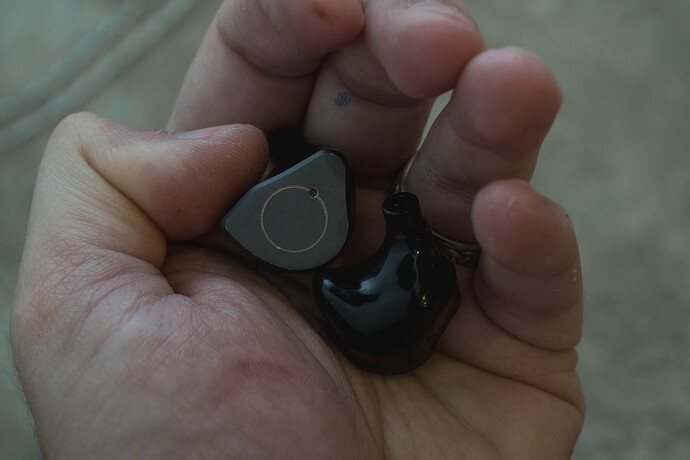Simgot SuperMix 4 In-Ear Monitor Review
Introduction and Disclaimer:
The Simgot SuperMix 4 is an in-ear monitor (IEM) with a quad-brid driver configuration. The SuperMix 4 contains a dynamic driver, a balanced armature (BA), a planar magnetic driver, and a piezoelectric driver in each earpiece. The SuperMix 4 retails for $149.99. Simgot sent me a review unit in exchange for my evaluation.
As you view the pictures in this review, please note that my unit tumbled onto concrete around a week and a half into my review. My frequency response measurements were also taken post-impact.
Unboxing and Accessories
The Simgot SuperMix 4 comes in a rectangular black cardboard box with a green slipcover. The front face of the slipcover features a skeleton view of the SuperMix 4’s driver arrangement. The rear face of the slipcover showcases the SuperMix 4’s frequency response and technical specifications.
The SuperMix 4 includes only three pairs of eartips in small, medium, and large sizes. These are the same poor-quality silicone eartips Simgot has included with their IEMs since I began reviewing their products years ago. I instead used a pair of Kinera Celest 608 eartips during my evaluation. The SuperMix4 also includes a black pill-shaped zippered pleather carry pouch. Finally, the package contains a user manual and a quality control pass chit.
Design, Build, Comfort, Fit, and Isolation
The Simgot SuperMix 4’s aluminum faceplates have a teardrop-shaped cross-section. The faceplates are engraved with a copper circle. There is a tiny circular mesh-covered vent at the bottom of the circle engraving. The thick black resin housings have a pseudo-custom fit. There is a brass plug with a circular vent offset from the 2-pin connector on each housing. The 2–pin connectors are flush with the surface of the housing. The nozzles feature three separate sound bores. At the bottom of the housing, a directional indicator and the text “SuperMix 4” are printed in gold along the edge of the seam between the housing and faceplate. The nozzles do not have a lip with which to secure eartips. However, the nozzles are on the thicker side, and I did not have any issues with eartips coming off the nozzles during my evaluation. I found the SuperMix 4 isolating, comfortable, and secure.
The braided 2-pin cable is both flexible and resistant to tangling. The straight 3.5mm jack and the Y-split hardware use the same gunmetal aluminum as the earpiece faceplates. There is a chin-adjustment choker fashioned from the same material. The cable has strain relief above the 3.5mm jack and the Y-split. The cable has clear plastic preformed ear guides, and the 2-pin connector housings are marked with blue and red bands to indicate left and right. The cable is moderately microphonic even while using the chin adjustment choker.
Sound
Simgot SuperMix 4 — Bedrock Reviews (squig.link)
The Simgot SuperMix4 has a U-shaped Harman-ish tuning with a substantial sub-bass elevation below 200 Hz and the best treble extension I have heard at this price point. In fact, the SuperMix 4 has better treble extension than any IEM I have heard below around $300. While there is a hint of distinctive ceramic piezoelectric timbre in the upper treble, compared to the earliest implementations of this driver type I heard several years ago, the SuperMix 4’s piezo driver is vastly better integrated.
Sub-bass extension is excellent, with a satisfying amount of rumble, and the sub-bass to mid-bass transition is smooth. The bass is cleanly articulated, resolving, textured, and impactful. There is no mid-bass bleed into the midrange.
The SuperMix 4’s midrange balance is more skewed towards the upper midrange than I would prefer. The lower midrange is a little recessed even for my tastes, and the ear gain region (centered at about 2.8 kHz) and the presence region are a little too forward. Male vocals are moderately lacking in body and are not as detailed, textured, or intelligible as female vocals. Female vocals are vibrant but closer to sibilance than I would like. Distorted electric guitars sound a tad overdriven and take on a degree of the buzzsaw-like character I dread so much, but there is no analog percussion compression. The overall midrange timbre is natural-sounding and avoids the plasticity historically associated with BAs.
The SuperMix 4’s treble response is class-leading. The balance between the presence region, lower treble, mid-treble, and upper treble is nearly perfect. There is a bit too much upper treble relative to the mid-treble. I assume the piezo driver is covering this range because cutting several decibels at 15 kHz or so not only helps the overall treble balance but completely neutralizes the faint piezo timbre, making treble transient delivery sound more natural. Even with this small imperfection, the SuperMix 4 is laudable. Overall detail retrieval is exceptional, the soundstage is wide, and instrument separation is terrific.
Conclusion
The Simgot SuperMix 4 offers the best treble extension on the market unless you spend double or more than its asking price. If you care about detail retrieval as much as I do, the SuperMix 4’s mildly exaggerated midrange and slight piezo timbre are well worth tolerating.
